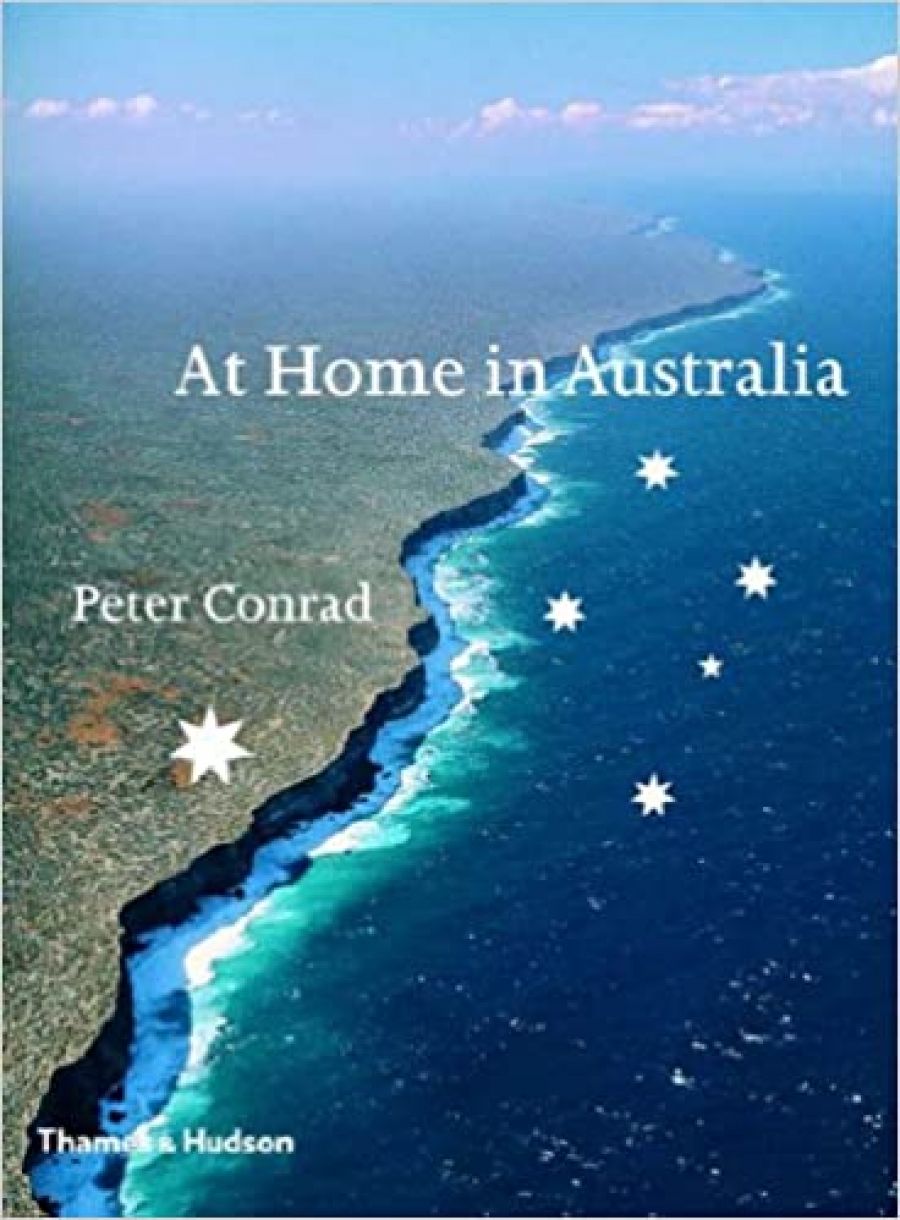
- Free Article: No
- Contents Category: Photography
- Review Article: Yes
- Online Only: No
- Custom Highlight Text:
We’ve been hectored by Miss Greer and savaged by Mr Hughes, but, like Goldilocks with the three bears’ bowls of porridge, Mr Conrad loves us just right. His book At Home in Australia is a collaboration between the National Gallery of Australia and Thames & Hudson, and more particularly between himself and Gael Newton, the gallery’s Senior Curator of Photography, who rang him in London with an invitation to write a book about the gallery’s photography collection.
Australia – an unfathomable condition to some, a mire of banality to others – is, like every other destination on our globe, a reservoir of interconnected entities. These entities are both material and emotional, and it is memory that unites them. Of a certain generation – Conrad’s generation – there will be few who are without the photograph of the naked baby on the picnic rug, with the fence palings and the hydrangea bushes in the background, or the toddler sitting astride the first dinky. This sort of recollection establishes the tenor of the book: a clear-eyed imperative to create a national family album, combined with a kind of stream-of-consciousness delivery.
Conrad (born in 1948) left Tasmania for the rest of the world – and Oxford in particular – when he was twenty. Like some displaced Russians of the 1920s, who longed for something that was not so much their homeland, as that tranquil patch called childhood, he invests considerable emotional energy in summoning it up. He imagines the camera as a metaphor for the ‘shuttered’ Hobart house of his parents, when the blinds were drawn. ‘Could the whole of the bright, dazing continent be cramped into that little room?’ He regards the act of photography as one of enclosure, so necessary an act to the first European settlers, who were incredulous at the Aboriginal notion of the open air and the raw ground providing a ‘home’.
The photographs are of interest, not so much as works of art (which of course they are, because they have been taken by our photographic top-guns: Poignant, Dupain, Moffatt, Moore, Cazneaux, and Cotton, to name a few) but as evidence of visceral life. The culture of the ‘rough and ready’ of ‘making do’ is poignantly expressed in Nicholas Caire’s Selector’s Hut, Gippsland (c. 1886). Stringybark festoons the scene, and everything has been made by hand: the barrels, the tools, the sheds and the barrow. We are reminded of Patrick White’s The Tree of Man, where axe-wielding man is locked in battle with the trees, and of his Riders in the Chariot, where nature scorns man’s efforts to make a mark in the void. One is also reminded of a riveting observation the art critic Donald Brook once wrote about a group of Tim Storrier’s outback paintings: ‘He has developed a compelling image of pale empty desert in which the primitive tools of civilisation stand like luggage unloaded from a train: surveyor’s poles, tents, corrugated iron, new bricks and bloody flags. Here in this desolation, you think, people are going to unpack and measure and build and kill each other all over again with their bits of marked stick and their calculating minds and their grotesque ambitions.’ In fact, Conrad assiduously weaves into his narrative novelists’ and poets’ imaginative responses to the tensions and self-inflicted incongruities between the town and the scrub, with frequent references to Murray Bail, Patrick White, Peter Carey and Les Murray.
In a chapter called ‘Tree People’, Conrad discusses the rupture of Aboriginal life and the camera’s collusion in forcing them to the margins. Trussed in European clothes and awkwardly posed, they are glum, dejected and alien – obliged to cooperate in their own dislocation. Closer to that region where man has temporarily tamed and enclosed nature by concreting it over, Max Dupain’s At Newport Baths, Sydney (1952) reminds us how the ripples on the blue tiles of the local swimming pool hypnotised us, while Jon Lewis’s Retired Beach Inspector, Bondi (1985) has us picking our way between the oiled bodies at Bondi.
There is plenty of opportunity for sending up our monuments and reflecting on our expanses. Hal Missingham, better remembered as the longest-serving director of the Art Gallery of New South Wales, photographed a stone kangaroo on the pediment of a Balmain grocer’s emporium with a swag on his back and a billy-can in one paw, while his Sandal on Eighty Mile Beach (1971) seems to have domesticated the spot where it rests, in a poised composition of light and shadow. Another surprise are the images by Eric Thake, who was better known as an Australian surrealist painter and a war artist with the RAAF. His Roadside Crucifix, Dumosa (1957) is a bleak image of a large black bird spread-eagled on a barbed-wire fence.
Unlike the tradition of portrait painting in this country, where only the illustrious or the thrusting find themselves fixed in pigment on canvas, the photograph wilfully preserves the unknown man in the street and those just passing by. There is the unknown woodchopper, the shearer, the lifesaver, the gassed soldier, the not so jolly swagman – but barely a suit in sight. One senses that Conrad, with his democratic and all-encompassing view of our culture, finds this utterly appropriate.


Comments powered by CComment